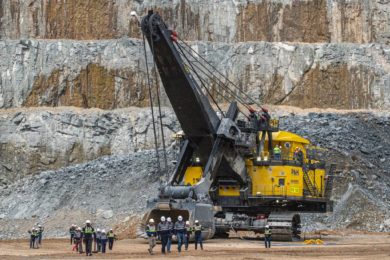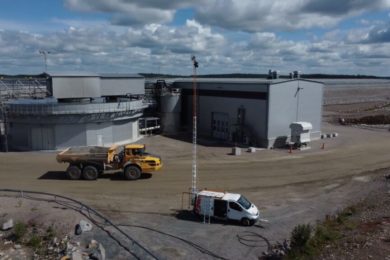 Kimberley underground mines
Kimberley underground mines
The company’s two large underground mines of Cullinan (May 2012, pp8-15) and Finsch (June 2012, pp10-13) have already been covered. Kimberley is the other very emotive name in the stable. Here at the home of diamond mining, Kimberley Underground comprises three kimberlite pipe mines in close proximity: Bultfontein (10 ha at surface), Dutoitspan (11 ha) and Wesselton (9 ha). These mines were integral to the economic development of South Africa as their output effectively financed development of the nascent gold industry. They are currently mining at depths of between 845 and 995 m below surface.
They have a history of producing large diamonds and fancy yellows, such as the Oppenheimer (253 ct rough and the Kimberley Octahedral (616 ct rough).
Petra’s expansion plan at Kimberley Underground envisages production rising from about 57,000 ct in FY 2011 to some 120,000 ct/y by FY 2013. Total resources (inclusive of reserves) amount to 7.1 Mct, to a currently known depth of 1,060 m. All three employ block caving at current depths of 845 m (Bultfontein), 870 m (Dutoitspan) and 995 m (Wesselton). Bultfontein is mined using a slusher drift block cave mining method simultaneously with the rim loading section. The Dutoitspan and Wesselton mines employ a slusher drift block caving method.
FY 2011 marked the first full year for Kimberley Underground under Petra management, following completion of the acquisition in May 2010. There was encouragement in the prices achieved for its production, with the average of $333/ct for the period considerably exceeding initial expectations. At the new Joint Shaft plant, which services the Bultfontein and Dutoitspan pipes, Petra experienced some initial difficulties relating to slimes and tailings disposal. To deal with the high percentage of fines material inherent in the Bultfontein and Dutoitspan ROM ore, Petra introduced a scrubber into the processing circuit, and is also introducing an apron feeder to handle material with a high level of mud content. It is anticipated that these measures will ensure adequate fines removal and increase throughput.
 Joint Shaft plant re-crush circuit at Kimberley Underground – a plant assistant cleaning the crusher sizing screen
Joint Shaft plant re-crush circuit at Kimberley Underground – a plant assistant cleaning the crusher sizing screen
The company has built up a ROM stockpile at surface, estimated to be 0.4 Mt in size, which gives flexibility to make up some of the lower recent production levels by processing higher tonnages once the plant throughput issues have been overcome.
The plan for processing at Wesselton involves a combination of a mobile pan plant together with a new plant (similar to that constructed at Joint Shaft). The new main plant at Kimberley remains on track for commissioning in Q4 FY 2012.
Unit costs of approximately R191/t in FY 2011 were negatively impacted by reduced throughput. These costs were expected to improve once the Wesselton plant is fully operational.
Of the $13 million capex in FY 2011, approximately $9.5 million was spent on improvements to the Joint Shaft treatment plant. A further $3.5 million was applied to the acquisition of adjacent land, buildings and infrastructure relating to water reticulation and slimes handling facilities (by assuming a rehabilitation guarantee).
 De Beers’ Kimberley processing plant that continues to recover diamonds from the tailings dumps
De Beers’ Kimberley processing plant that continues to recover diamonds from the tailings dumps
Kimberley Underground has a current mine plan of 11 years, which could be extended as Petra more thoroughly investigates the resources of these mines at depth and the East Blow at surface.
De Beers continues to manage its surface mining (tailings recovery) at Kimberley, which operates independently of the underground mine workings. It has a custom-built recovery plant developed to efficiently treat and to recover diamonds which produces some 400,000 ct/month. De Beers expects Kimberley diamond recovery operations to continue through 2023.
Expanding Koffiefontein
Koffiefontein (11 ha pipe at surface) is one of the world’s top diamond mines by average value per carat and produces exceptional white and coloured diamonds, a regular proportion of which are of between 5 and 30 ct. Underground mining of the high value, low-grade Koffiefontein kimberlite pipe is supplemented by tailings treatment from a 65 Mt tailings deposit and open-pit mining of the 5 ha satellite pipe named Ebenhaezer.
 Open-pit mining at the satellite Ebenhaezer pipe at Koffiefontein
Open-pit mining at the satellite Ebenhaezer pipe at Koffiefontein
Total resources (inclusive of reserves) amount to 6.1 Mct, to a current depth of 690 m, though the orebody remains open-ended at depth. The current mining method is front cave, currently at a depth of 490 m. The mine plan is for 14 years but the potential life could be more than 20 years.
Koffiefontein achieved an average value per carat of $564 for FY 2011, up 40% on the comparative period despite the overall average being reduced to some extent by a higher proportion of lower value tailings production in the total sales mix. ROM production for the year was 35,139 ct (H1 FY 2011: 27,390 ct; H2 FY 2011: 7,749 ct). Tailings production was 12,817 ct for the period (H1 FY 2011: 7,110 ct; H2 FY 2011: 5,707 ct). Capex of $11 million for FY 2011 was mostly spent on underground development and mining equipment.
 Koffiefontein – Mining overview
Koffiefontein – Mining overview
Waste ingress and reduced production from 52 level significantly affected the ROM grade (3.1 ct/100 t in H2 FY 2011 as compared to 5.9 ct/100 t in H1 FY 2011). As at Cullinan and Finsch, Petra’s development plan at Koffiefontein will establish new production levels where the company will eventually have access to undiluted ore. Once this has been achieved, Petra expects the overall ROM grade at Koffiefontein to improve to about 8 ct/100 t, but it is expected that lower ROM grades could be reported until FY 2014.
Extensive stress modelling simulations have indicated that the planned front cave at the 580 m level be changed to a sub-level cave mining method between the 560 and 600 m elevations. It is expected that this plan will be executed within the original timetable and capex forecasts, with annual production expected to reach 1 Mt/y in approximately three years and reach 1.2 Mt/y in about five years, delivering over 100,000 ct/y (ROM and tailings) by FY 2017.
Different Fissures
The Fissure Mines consist of three mines Helam, Sedibeng and Star which are unusual mines in that the diamonds are extracted from kimberlite dykes and not pipes. Northland Capital noted in its report on Petra of March 8, 2012 that “dykes are narrower and more difficult to mine and as a result, the mining cost per tonne is around seven times that of a kimberlite pipe. This financial year (2012), Petra is expected to produce 2.2 Mct over all its operations, an increase of 100% on last year. The Fissure’s will contribute around 5% of the total carats and 8% of revenue generated this year. As Petra continues to expand its production to just under 4 Mct by 2014, the Fissures contribution will drop to 3% of the total carats produced and 4% of the revenue.”
The Sedibeng operation is an amalgamation of two mines: Messina and Dancarl. The mines are operating at depths of between 600 and 750 m. Plans to increase production from just over 87,000 ct in FY 2011 to 140,000 ct/y by FY 2015 are currently being implemented.
The strike lengths of the fissures at surface ae 6 km at Helam (depth of current mining 750 m), 2.4 km at Sedibeng (750 m) and 4.5 km at Star (620 m). Helam and Sedibeng employ full shrinkage overhand stoping, while Star is an open stope underhand operation.
Helam and Sedibeng put in a strong performance in FY 2011, with revenue for the Fissures unit as a whole up 62% to $21.8 million and overall production up 18% to 87,488 ct. The average value per carat achieved also increased 32% to $244. For FY 2012, Petra expects a similar level of combined production across the fissure portfolio to FY 2011.
At Star, “where operations are challenging, a disappointing performance was recorded for the year, as reflected in the impairment charge incurred,” Petra reported.
Unit costs for the Fissures remain flat despite cost pressures specifically relating to electricity and labour. The majority of the $5.2 million capex in FY 2011 was spent on continuing underground development across the fissure mines including a headgear installation at Sedibeng’s Dancarl shaft.
Additionally, $11.0 million was spent in respect of the Helam projects manufacturing facility for equipment under construction for other mines and projects within the Group.
Northland Capital further reported that “the Fissure mines have a total resource of just under 5 Mct with an average diamond value of $255/ct. The large amount of maintenance capex spent by Petra from 2009 to 2011 has ensured that the mines will continue to produce at their current rate with a low maintenance capex for years to come.” IM









